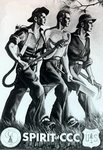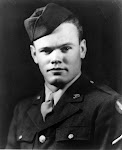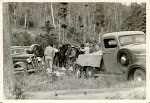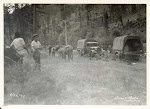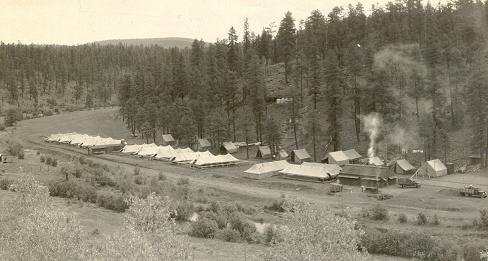In my last post at the Civilian Conservation Corps Resource Page, I spoke of tying up loose ends and how those loose ends don’t always bind up as nicely as we might like. In that particular case, the loose ends didn’t quite come together but it was an exciting moment or two as I sought to identify where a particular photograph might have come from.
As it turns out, there’s a loose end here at Forest Army and as luck would have it, the ends came together much more neatly this time around. In a post I made back in late 2010 I editorialized regarding the standardization and regimentation that were such an important part of the CCC’s success (you can see that post here.)
At that time, I was mystified by the purpose of a particular pole or post installation that I’ve encountered both in photographs and in the field. The pole looked like this in a photograph that I obtained from the National Association of CCC Alumni (NACCCA) back in the early 1990s.
I found a surprisingly similar pole installation at the site of a former CCC camp in Yavapai County, Arizona and have ruminated on its purpose ever since. It seems clear that a standard set of plans guided the construction and installation of poles like these; how else do you explain the striking similarity between two examples when one example is at Grand Canyon National Park and the other in a U.S. Forest Service CCC camp near Prescott, Arizona? But what were these posts or poles used for?
At the time, I wrote, “I’ve no idea what the purpose of the twin pole arrangement is; perhaps it was part of a gate, or perhaps it was one in a series of telephone or telegraph poles strung through the juniper…one wonders why the photographer even bothered with snapping the picture at all.”
Well, we’ve tied the loose ends together this time, thanks to some fortuitous help from a prolific local CCC researcher. About a week ago I received an email from Robert “Ranger Bob” Audretsch, who’d just wrapped up some research at the Grand Canyon museum. He attached one photo as representative of about “60 great photos” that he’d found for a project he’s working on. I don’t have the faintest clue why Bob picked the particular photo that he attached to his email but the second I opened it up, I knew that all the uncertainty surrounding the CCC mystery poles at Grand Canyon and Walnut Creek was cleared up. Sometimes the loose ends tie themselves up without much help.
The picture Ranger Bob emailed me shows three CCC boys working on a string of telephone or telegraph poles, with two guys cinching up the posts while a third guy strings the wire atop the pole. I’m wondering if it was safe for one enrollee to be climbing atop the pole before it was fully wired into place, but I suppose that was a matter for the project foreman to worry about. At any rate, they all appear to be working really hard; the camera captures them in something of a blur. There is no doubt that this photo depicts the same project that is depicted in the rather innocuous photo that I received from the NACCCA collection so many years ago and I’m pleased and proud to post them side by side here, perhaps for the first time ever.
Armed with the Grand Canyon telephone pole photo from Ranger Bob, I can now easily conclude that the similar pole installation I saw still standing at the former site of the Walnut Creek CCC camp was or a telephone or other type of wire strung to or through the camp. Who can guess what sorts of communications passed that way while the camp was in operation; we’ll never know, but we at least know why those poles were placed in the ground.
You can find more information about Ranger Bob Audretsch, his CCC research, and his book at his website CCC Books. Pay him a visit, look around, buy a book!
